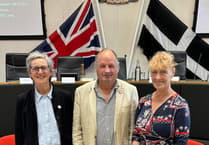NEXT time you visit Truro Cathedral, pause to look at the large grey memorial just inside the entrance. The war it commemorates changed the course of history.

The Boer War was fought between the British Empire and Dutch-speaking Boer settlers in what is now northern South Africa. The flashpoint was the discovery in 1886 of colossal goldfields in the Dutch-settled Transvaal and the Orange Free State. Rural backwaters were suddenly transformed into ‘Wild West’ mining towns, filled with prospectors from around the globe - including Cornish miners and engineers thrown out of work by the collapse of the tin industry.
The Boers deeply resented the incomers as ‘uitlanders’ (foreigners), and when speculators such as Cecil Rhodes began to pressure the British Empire to move in, the Boers decided on a pre-emptive strike. Fighting broke out on October 11, 1899 - 125 years ago this month.
Initially, the Boers were successful, aided by superior rifles, leadership and tactics; but the Empire struck back. Within a year, it had captured all the towns, but still the Boers would not give up. They clung on until 1902, using guerilla tactics to strike supply lines until forced into submission by a brutal ‘scorched earth’ policy, adopted by British commander Lord Kitchener (later the face of the First World War recruitment poster).

By then, more than 6,000 Boer and 22,000 Empire troops had died, many from disease. The anxiety suffered by soldiers’ families is illustrated by the businessman F Walters Bond, who presented his valuable ‘Tinworth’ terracotta panel to Truro Cathedral as an offering of thanks to God for the safe return of his two sons.

Truro’s Boer War Memorial has two bronze statues of soldiers keeping vigil for their fallen comrades. Of the 192 men named, more than half served with the Duke of Cornwall’s Light Infantry, while others were already working in the area at the outbreak of war and signed up to defensive militias. Inscriptions include Pte S Richards of Camborne (Namaqualand Town Guard); Pte W Lawrence of Redruth (Police Volunteer Force) and Pte M Magor of Truro (Railway Pioneers).

Today, the Boer War is remembered not only for changing the political map of Africa but also as the forerunner 20th-century warfare. The Boers used machine guns, trenches and guerilla resistance, while on the British side, Kitchener pursued a terrible new weapon: concentration camps. Africans and Boers alike were interned in appalling conditions, with starvation rations. Some 46,000 civilians, most of them children, died of hunger and diseases like typhoid.
The death toll would have been even worse if not for the efforts of Emily Hobhouse, daughter of the first Archdeacon of Bodmin. She travelled to the area and, despite vilification from Kitchener and senior politicians, would not be silenced in exposing the scandal of the Boer camps and forcing the government to improve conditions. Her life is commemorated in Bloemfontein, South Africa and at a new museum at her family home in St Ive, near Liskeard.
Entry to Truro Cathedral is free; donations are appreciated. www.trurocathedral.org.uk





Comments
This article has no comments yet. Be the first to leave a comment.